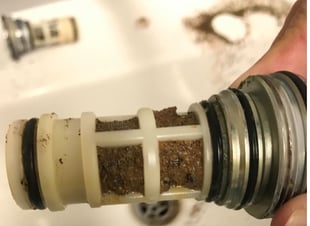
If we’re to control the ‘chain of infection’ we must first understand what it entails so that we can identify what is within our control. In doing so, this may enable us to devise and implement an effective ‘preventative management strategy’ to mitigate the risk of infection and subsequent disease.
The chain of infection can be defined as the events and factors leading to infection and subsequent disease which can be underpinned by two key considerations:
- Environmental considerations,
- Clinical considerations.
Environmental Considerations
Microorganisms are ubiquitous in the environment! Therefore, whilst there’s little that may be done about these environmental bacteria, our focus should be centred on ensuring that we adequately manage ‘risk systems’ such as water systems (and associated components) so that they don’t become colonised and a reservoir for contamination.
If then, we accept that our water systems (and associated components) frequently contain a variety of different waterborne bacteria. Eliminating bacteria from our water systems may not reasonable or practicable (as our water is not a sterile product…) therefore the effectiveness of our preventative management strategy will depend upon how well we control the bacterial load within these water systems (and associated components) to mitigate potential colonisation.
We should base our preventative management strategy around the understanding of biofilm formation and the associated challenges of managing biofilm bacteria as opposed to free-floating, or planktonic bacterial, cells. Bacteria are more likely to colonise water systems (and associated components) if conditions are conducive, such as; nutrient-rich, slow-moving or stagnant water within a temperature range of 20-45˚C.
 Within such conditions, planktonic bacteria will move towards the inner surface of pipework and adhere to these surfaces using protein structures known as bacterial pili (fimbriae). These hair-like structures on the outside of the bacterial cell wall will attach the bacteria to the surface and certain (primary-infecting) bacteria like Pseudomonas will very quickly start producing biofilm for other bacteria of the same and different genera and species to live within. This disconcerting phenomenon often allows bacteria to share resistance characteristics as the bacterial pili have also been demonstrated to facilitate the transfer of resistance genes and attachment to surfaces – evidenced by the phenotypic differences between planktonic and biofilm bacteria.
Within such conditions, planktonic bacteria will move towards the inner surface of pipework and adhere to these surfaces using protein structures known as bacterial pili (fimbriae). These hair-like structures on the outside of the bacterial cell wall will attach the bacteria to the surface and certain (primary-infecting) bacteria like Pseudomonas will very quickly start producing biofilm for other bacteria of the same and different genera and species to live within. This disconcerting phenomenon often allows bacteria to share resistance characteristics as the bacterial pili have also been demonstrated to facilitate the transfer of resistance genes and attachment to surfaces – evidenced by the phenotypic differences between planktonic and biofilm bacteria.
Once a ‘mature biofilm’ has formed within a water system, the microorganisms that live within it are often well protected by the ‘architecture’ of the biofilm –making it very difficult for remediation methods to demonstrate long-term effects which may eventually lead to the affected system being replaced which can be time consuming, disruptive, and expensive. Moreover, the impact of biofilms on the pathogenicity of microorganisms that live within it is a major public health consideration, when you consider the possibility of individuals/patients becoming infected with multidrug-resistant strains of bacteria.
Clinical Considerations
The clinical consideration needs to start with the ‘transmission pathways’ (how a pathogen may cause infection and subsequent disease) and then consider the clinical outcome which may be determined by pathogenicity and the immune status of those affected by a pathogen, as the probability of a poor prognosis is higher when immunocompromised or neutropenic individuals are infected by pathogenic microorganisms.
Three routes of transmission/transmission pathways exist when individuals become infected by a microorganism:
- Direct contact
- Inhalation/aspiration
- Ingestion
The route of transmission may vary dependent upon the microorganism, for example; ‘opportunistic’ pathogens (so called because they await a breach in the host defences) such as Pseudomonas aeruginosa may be spread through direct contact with the pathogen, whereas pathogens such as Legionella pneumophila may only be acquired following the inhalation or aspiration of aerosolised water droplets containing the pathogen, and ingestion may define the route of transmission for enteric illness caused by pathogens such as Escherichia coli.
Following the adequate processing of water by the water undertaker – ensuring that ‘wholesome’ water is delivered to the point of entry of buildings connected to a mains supply, contamination with enteric pathogens (relating to or occurring in the intestines) is seldom a concern within the UK, but the adequate management of Pseudomonas and Legionella bacteria remain a Duty Holder responsibility.
As such, the ACoP L8, HSG 274 (Parts 1, 2, 3) and for healthcare organisations, HTM 04-01 (Parts A, B, C), detail a set of guidance notes which can be used to safely manage water distribution systems. These guidance documents are the backbone of effective control schemes and compliance is considered the ‘minimum requirement’.
In closing, detailed knowledge of your water systems, their design, operation and components (environmental considerations), coupled with knowledge about those who may be exposed to these systems i.e. the end user be it a member of staff or someone who is immunocompromised, will help those responsible for the water system (Responsible Person/Authorised Person) to decide what actions are necessary to break the chain of infection.
Feel free to reach out if you have any questions about the issues mentioned above or if you would like to consult with one of our experts on water hygiene.
Editors Note: The information provided in this blog is correct at the date of original publication – September 2022.
© Water Hygiene Centre 2022








